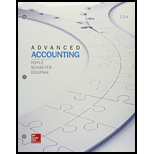
ANALYSIS CASE—
On February 1, 2017, Linber Company
Linber’s financial statements reported the following amounts related to this cash flow hedge (credit balances in parentheses):
| Income Statement | First Quarter 2017 | Second Quarter 2017 | |
| Premium expense | $4,000 | $ 2,000 | |
| Cost of goods sold | –0– | 103,000 | |
| Adjustment to net income | –0– | 3,000 | |
| Balance Sheet | 3/31/17 | 5/1/17 | |
| Forward contract (liability) | $(1,980)* | $ –0– | |
| AOCI (credit) | (2,020) | –0– | |
| Change in cash | –0– | (106,000) | |
*$2,000 × 0.9901 = $1,980, where 0.9901 is the present value factor for one month at an annual interest rate of 12 percent calculated as 1/1.01.
Required
- 1. On February 1, 2017, what was the U.S. dollar per euro forward rate to May 1, 2017?
- 2. On March 31, 2017, what was the U.S. dollar per euro forward rate to May 1, 2017?
- 3. Was Linber better off or worse off as a result of having entered into this cash flow hedge of a forecasted transaction? By what amount?
- 4. What does the total premium expense of $6,000 reflect?
Want to see the full answer?
Check out a sample textbook solution
Chapter 9 Solutions
GEN COMBO ADVANCED ACCOUNTING; CONNECT ACCESS CARD
 Financial Reporting, Financial Statement Analysis...FinanceISBN:9781285190907Author:James M. Wahlen, Stephen P. Baginski, Mark BradshawPublisher:Cengage Learning
Financial Reporting, Financial Statement Analysis...FinanceISBN:9781285190907Author:James M. Wahlen, Stephen P. Baginski, Mark BradshawPublisher:Cengage Learning

